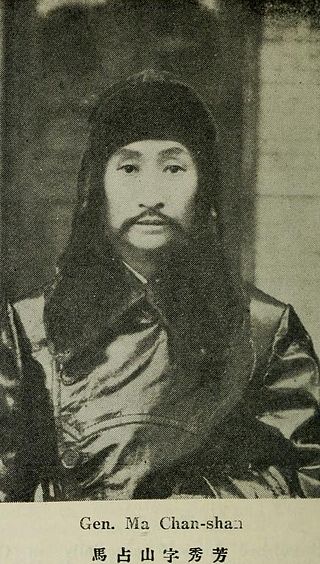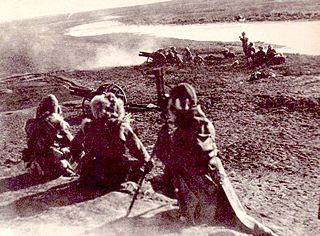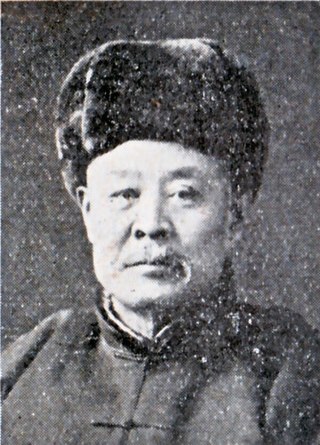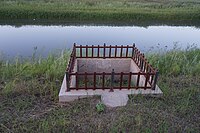
The Mukden incident was a false flag event staged by Japanese military personnel as a pretext for the 1931 Japanese invasion of Manchuria.

Qiqihar is the second-largest city in the Heilongjiang province of China, in the west central part of the province. The built-up area made up of Longsha, Tiefeng and Jianhua districts had 959,787 inhabitants, while the total population of the prefecture-level city was shrinking to 4,067,489 as of the 2020 census. These are mainly Han Chinese, though the city is also home to thirty-four minorities including Manchus, Daur, and Mongols.

The Nen River or Nenjiang, or Nonni is a river in Northeast China. The Nen River flows through the northern part of Heilongjiang Province and the northeastern section of Inner Mongolia, some parts of the river forming the border between the two regions. At 1,370 km (850 mi) in length, the Nen River is the longest tributary of the Songhua River.

Zhang Jinghui ; was a Chinese general, warlord and politician during the Warlord era. He is noted for his role in the Japanese puppet regime of Manchukuo in which he served as Prime Minister for most of its existence.

The Manchukuo Imperial Army was the ground force of the military of the Manchukuo, a puppet state established by Imperial Japan in Manchuria, a region of northeastern China. The force was primarily used for fighting against Communist and Nationalist guerrillas in Manchukuo but also took part in battle against the Soviet Red Army on several occasions. It initially consisted of former National Revolutionary Army troops of the "Young Marshal" Zhang Xueliang who were recruited after the Japanese invasion of Manchuria en masse, but eventually expanded to include new volunteers and conscripts. The Imperial Army increased in size from about 111,000 troops in 1933 to an estimated strength of between 170,000 and 220,000 soldiers at its peak in 1945, being composed of Han Chinese, Manchus, Mongols, Koreans, Japanese, and White Russians. Throughout its existence the majority of its troops were considered to be mostly unreliable by their Japanese officers and advisers, due to poor training and low morale.

The Jiangqiao campaign was a series of battles and skirmishes occurring after the Mukden Incident, during the invasion of Manchuria by the Imperial Japanese Army, prior to the Second Sino-Japanese War.

Ma Zhanshan was a Chinese general famous for resisting the Japanese invasion of Manchuria. Ma was placed in charge of the Northeastern Army in Heilongjiang Province during the invasion and ignored orders from the central government not to resist the Japanese. He became a national hero in China by fighting the unsuccessful but highly symbolic Jiangqiao campaign against the Kwantung Army's advance into Heilongjiang. After his defeat, he feigned defection to the Japanese and was appointed Minister of War in the new Japanese puppet state of Manchukuo. He then joined and took command of the guerrilla campaign against Japanese occupation, taking with him large amounts of supplies, funds, and military intelligence. Ma Zhanshan rejoined the Northeastern Army after the guerilla movement was largely defeated. He continued to oppose Chiang Kai-shek's policy of non-resistance and supported the Xi'an Incident that forced Chiang to form the Second United Front with the Chinese Communist Party (CCP). He commanded several units in the National Revolutionary Army during the Second Sino-Japanese War while covertly cooperating with the CCP. Ma avoided direct participation in the postwar Chinese Civil War and eventually defected to the Communists, dying a year later in 1950.

The Empire of Japan's Kwantung Army invaded Manchuria on 18 September 1931, immediately following the Mukden Incident. At the war's end in February 1932, the Japanese established the puppet state of Manchukuo. Their occupation lasted until the success of the Soviet Union and Mongolia with the Manchurian Strategic Offensive Operation in mid-August 1945, towards the end of the Second World War.
The Defense of Harbin occurred at the beginning of the Second Sino-Japanese War, as part of the campaign of the Invasion of Manchuria by forces of the Empire of Japan from 25 January to 4 February 1932. The Japanese took the city only after a long battle against the Chinese.

Ding Chao was a military general of the Republic of China, known for his defense of Harbin during the Japanese invasion of Manchuria in 1931 and 1932.

The Jinzhou Operation or Chinchow Operation was an operation in 1931 during the Japanese invasion of Manchuria, which was a preliminary, contributing factor to the outbreak of the Second Sino-Japanese War in 1937.

The Pacification of Manchukuo was a Japanese counterinsurgency campaign to suppress any armed resistance to the newly established puppet state of Manchukuo from various anti-Japanese volunteer armies in occupied Manchuria and later the Communist Northeast Anti-Japanese United Army. The operations were carried out by the Imperial Japanese Kwantung Army and the collaborationist forces of the Manchukuo government from March 1932 until 1942, and resulted in a Japanese victory.

Su Bingwen, was a Chinese military leader. Graduating from officers school in 1914 he joined the Model Regiment as a platoon leader in 1916, became a company commander, and then battalion commander. He served in the Fujian Army in 1920 as the first Army Brigade Chief of Staff, then the Chief of Staff 13th brigade of the Northeast Army. In 1921 he commanded the 6th Army brigade in the north east, then the 17th Division office in 1927. In 1928, Su became Jiang's chief of staff and deputy commander of the northeastern border National Defense Office Directory. First in 1930 as the military commander of the Eastern Railway garrison then, the Hulunbuir garrison commander in 1931 in charge of the Heilongjiang garrisons of the "Barga District" at the extreme west of Heilongjiang on the Soviet frontier.
After the Japanese invasion of Manchuria, and until 1933, large volunteer armies waged war against Japanese and Manchukuo forces over much of Northeast China.
Wang Delin was a bandit, soldier, and leader of the National Salvation Army resisting the Japanese pacification of Manchukuo.
Ma Zhanshan, a general in the Chinese Army who had surrendered in January 1932 and joined the Manchukuo regime, rebelled again in late April, forming his own volunteer army in Heilongjiang province at the beginning of May, and then he established another 11 troops of volunteers at Buxi, Gannan, Keshan, Kedong and other places and thus established the Northeast Anti-Japanese National Salvation Army with Ma appointed as Commander-in-chief, with the other volunteer armies as subordinates at least in name.
Tangchi is a town in Tailai County, western Heilongjiang province, Northeast China, about 43 kilometres (27 mi) south-southwest of the prefecture city Qiqihar.

Zhang Haipeng, was a Chinese Northeastern Army general, who went over to the Japanese during the Invasion of Manchuria and became a general in the Manchukuo Imperial Army of the State of Manchuria.

Aisin-Gioro Xiqia (Aisin-Gioro Hsi-hsia; Chinese: 愛新覺羅·熙洽; pinyin: Àixīnjuéluó Xīqià; Wade–Giles: Ai4-hsin1-chüeh2-lo2 Hsi1-ch'ia4; 1883–1950), commonly known as Xi Qia or Xi Xia (Hsi Hsia; Chinese: 熙洽; pinyin: Xīqià; Wade–Giles: Hsi1-hsia4; Hepburn: Ki Kō), was a general in command of the Jilin Provincial Army of the Republic of China, who defected to the Japanese during the Invasion of Manchuria in 1931, and who subsequently served as a cabinet minister in Manchukuo.
The Qiqihar–Bei'an railway or Qibei railway, is a single-track railroad in northeastern China between Qiqihar and Bei'an in Heilongjiang Province. The line is 231 km (144 mi) long and was built between 1928 and 1933. Major cities and towns along route include Qiqihar, Fuyu, Keshan and Beian.














